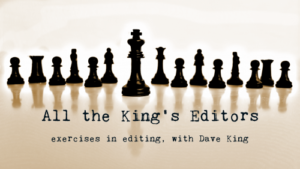Editing
The comments section, where readers start bringing their own intelligence and experience to the conversation, is often the best part of a Writer Unboxed article. For instance, three months ago, I talked about what the music of J. S. Bach can teach us about setting up surprise in fiction. Donald Maass then got on in the comments and gave an elegant summary of the different flavors of surprise.
Since surprise is so critical to good storytelling – predictability is boring — I’d like to expand on Don’s comments (with his permission). Because it’s important to not only understand what surprise is, but to understand just how you can pull it off. A warning up front: spoilers abound.
“In one way, surprise is nothing more than what you, the author, know will happen that the reader doesn’t. Don’t tell. Lead the reader to expect something else.”
Generations of mystery writers have developed techniques for leading the reader to expect something else, and we can only cover a couple here. But the clue-hiding techniques set up surprise at its most basic, so they make a good place to start.
The most basic technique is to throw a lot of details at your readers so the essential facts get lost in the weeds. And just because this technique is basic doesn’t mean the novels that use it are second rate. In Who’s Body, Dorothy Sayers buried the critical detail that the suspect was a mountain climber (and thus able to rappel down from the roof and deposit the mysterious body) among details of schooling and employment history in the character’s Who’s Who entry.
Read MorePlease welcome multipublished author Lynne Griffin to Writer Unboxed today!
Lynne is the author of the novels Girl Sent Away (SixOneSeven Books), Sea Escape (Simon & Schuster) and Life Without Summer (St. Martin’s Press), and the non-fiction guides, Let’s Talk About it: Adolescent Mental Health (SixOneSeven Books) and Negotiation Generation (Penguin). In addition to teaching at GrubStreet, Lynne teaches in the graduate program of family studies at Wheelock College. She is the family life contributor for Boston’s Fox Morning News and writes for Psychology Today. Her short fiction, essays, and articles have appeared in Slate, Brain, Child, Parenting, Scholastic Parent & Child, Psychology Today, The Writer, The Huffington Post, The Boston Globe, The Drum Literary Magazine, Parents, and more.
For more about Lynne’s work, visit her website.
Dying to Know, Afraid to Find Out: Building Tension in Fiction
No matter the narrative, we read to explore human behavior and the intricacies of social and emotional life. Good stories ask us to contemplate universal questions, like “Are we in control of our lives?” or “Will we be punished for our sins?” or “What do we need most in the world to feel whole, to be loved?”
I read Donna Tartt’s The Goldfinch to find out if Theo was ever held responsible for stealing the painting after surviving the terrorist attack in the museum. Yet mostly I read to learn how precious art might help or hinder the way a child grieves the loss of his mother.
I knew very little about displaced persons from Iran until I was introduced to the Behrani family in House of Sand and Fog by Andre Dubus III. I read this riveting novel of suspense because I needed to find out whether it would be Kathy or the Colonel who would win possession of the house in the California Hills. Except the more powerful reason I read was because the story asked me to imagine what it feels like to be someone forever at war with inequality and injustice. And to consider what I might be willing to do to hold onto the only place I had left to call my home.
The answers to existential questions in life don’t come easy. And they shouldn’t in fiction either. Compelling stories have the ability to draw us in. They challenge our present attitudes, often shifting our perspectives. To put it simply, there are no absolutes. As in The Goldfinch and in House of Sand and Fog, stealing is wrong until it isn’t.
Well-crafted stories don’t make difficult questions easier to answer, just easier to ponder. It’s the writer’s job to raise questions readers want to grapple with, and we do it by creating tension on every page, working through the messy lives of complex characters. Exploiting every element of craft, the writer engages in a delicate dance of creating compelling story questions that put readers on edge while not confusing or frustrating them.
How do writers achieve the right level of tension?
It’s this very discomfort over what’s about to happen and what characters stand to lose that keeps readers turning pages. Without some sense that characters might fail (or in the absence of believable conflicts and something valuable at stake) we have no reason to […]
Read MoreThere’s a limit to what you can learn about writing from reading about it. Yes, articles can explain techniques you can use or point out traps you might fall into. They can help you see some aspects of your writing more clearly.
But when you try to put all this advice into play, you find that everything is connected to everything else. Changing one character’s voice can affect how other characters react to him or her, which could change the direction of your plot. Describing a setting in more detail might color the mood of the scene, so that the dialogue no longer seems to fit quite so well. Even a mechanical change like how often you paragraph can increase your pace and affect the amount of detail you need to include.
Which is why we’re kicking off a new feature here at Writer Unboxed — the Editor’s Clinic. We’re asking brave volunteers to submit a few pages from their work in progress. (This initial example is from a client, used with his permission.) Then I or one of the WU editorial stable will work our magic and post the results here. And this gives you a chance to see how editors apply writing advice in its natural habitat. It gives us a chance to get away from the theoretical and get real.
If you’d like to give it a go, you can send a sample of your work (no more than five pages) to dave@davekingedits.com. Feel free to include any questions you might have about the passage, and we’ll try to get them answered. And please feel free to join in the discussion — they’re often the best part of the article.
We’re still feeling our way with this, so we’re not sure yet how often the clinic will appear or who the editorial stable will include. But I’ve done similar things in the past, and they’ve been a lot of fun.
So watch this space.
And here’s the opening sample. The narrator, April, is being stalked by Josh, someone she used to know. Richard is the current boyfriend. The notes appear at the end.
Read MoreI recently received a critique of a work in progress that suggested I alter the point of view (POV) from distant third person to close third person. It was good advice, but it meant facing another rewrite of what I thought was a completed manuscript. I told myself I could do it—after all, it would just be wordsmithing. I would leave the scenes as is, just go a little deeper into the characters’ psyches. I would not, of course, be rewriting entire scenes or large-scale plot details.
Before I started on the revision, I did a little research to augment my basic understanding of the differences between distant and close third person. I found numerous blogs and articles (links to some of the more helpful ones are at the end of the post) but I came away with three takeaways about close third person POV:
I set a schedule to finish the editing in two months—one chapter every two to three days. Each chapter was told from a different characters’ viewpoint, so I expected the editing would simply bring more life to the book by making each character more vivid.
Editing the first few chapters went smoothly, but they were strong chapters with clear motivations, conflicts, and actions. Three weeks into the editing, I got to a part of the manuscript that was not as strong. In particular, I got to the chapters told from the viewpoint of a female protagonist who had played a decisive and active role in the opening chapters, but who then became passive in later chapters as events played out on larger stages. I had struggled with those chapters and that character’s passivity through many revisions, and while I had given her more to do, the chapters were still flat.
When I started rewriting those troubled chapters, the simple editing became something far more complex. It was as if the closer POV gave that character back the voice that had been suppressed, and she was not about to sit passively still while chaos rained down upon her. She became active, not passive. And every time she chose to do something rather than let things be done to her, she created new plot elements, entire storylines, new possibilities that would echo through the work to the end.
I stalled out on the editing because it was becoming far more change, and far more work than I had bargained for. At a loss to know whether to stop or to continue, I sat down and just re-read the manuscript, to figure out whether it was worth all the work.
Read MorePlease welcome Jim Dempsey back to Writer Unboxed today! Jim is a professional member of the Society for Editors and Proofreaders and works as a book editor at a company called Novel Gazing. In his own words, Jim tells us that:
‘I’ve been editing for a little more than 20 years, gradually making the shift from nonfiction to fiction, which is where my heart really lies. After a few years, I was so busy editing novels that it made sense to pool resources with another two editing friends, and together we set up our own company called Novel Gazing. That was in 2012, and although I have continued with a few nonfiction clients, I spend most of my time editing fiction for publishers and self-publishing authors. I enjoy the challenge of fiction, making sure all the pieces fit together to make a perfect whole.’
You can learn more about Jim and his services on his company website, and by following him on Twitter (@jimdempsey and @novel_gazing).
How to Keep Track of All Your Novel’s Details
I recently worked on a story that had two Mondays in the same week. When I pointed this out, the author was so embarrassed to have made such an obvious error, but it’s a simple mistake to make. Raymond Chandler apparently forgot to reveal who killed the chauffeur in The Big Sleep, and one character in The Iliad was still around to witness his son’s death even though Menelaos had killed him much earlier.
It’s those minor characters that are usually the problem. The little details. You know your main characters perfectly, you can see them in your mind’s eye. But was her mother born before the war or just after? Did he meet his first wife when he was a freshman or was he already a sophomore?
Editors have a similar problem when they start to work on your book. They don’t know anything about your characters, the world they live in, who did what or when, but they still have to keep track of it all. They have to be able to point out that John, who had a bad limp in chapter 3, is now escaping over back-yard fences like an Olympic hurdler or remind you that the witness spoke with a heavy British accent when she was first interviewed but sounds more like a Southern belle when the inspector revisits her later in the book.
Keeping track of all of these details and idiosyncrasies is essential for the editor, and it’s useful for authors too to make sure your characters, settings, style, and backstories are consistent.
Avoid confusion
Having two Mondays in the same week and other issues with your story’s timeline in particular can be time-consuming errors to correct. It can mean that everything after that blip gets knocked out of sync too. And a simple find-and-replace to change every Monday to Tuesday won’t work as you then have to change every Tuesday to Wednesday and so on, plus check for every mention of ‘yesterday’ and ‘tomorrow’ and ‘day before’ too.
More importantly, a disturbed timeline can confuse readers: ‘I thought the murder happened on Monday, but now she’s saying today is Monday.’ […]
Read MoreThat title doesn’t appear to make much sense, does it? You might be thinking, do you even know what those words mean? One is either a plotter or a pantser. If you’re a plotter, you outline. You like to know where you’re going before you set out on your novel’s journey. You may choose to turn right where your outline indicates you will turn left, but that will be a conscious diversion. Order. You must have order.
Pantsers, on the other hand, thrive on spontaneity and the unknown. If you’re a pantser, you just get in the car and drive. You introduce yourself to your characters and let them navigate; you allow yourself to become their instrument. Outlines are like nasal-voiced GPS programs constantly chirping reprimands at you each time you deviate from the pre-approved route. SHUT UP, they make you want to shout. Don’t bother me with directions. I will feel where I want to go.
Me? I’m a pantser. When I write, I always hope to find myself in The Zone, that place composed of buzz and bliss where I forget I’m typing and the words surprise me as they appear on the page, outcome unknown. What do you mean it’s 5:00? Wasn’t it just lunchtime? Whoa, did Sage just drop the key to the whole story in her admonishment to her sister? I didn’t know she was going to do that. Did Michael just die in that accident? Where did that come from? That’s not where I thought this was going, but it’s great. I’m going to follow this trail and see where it takes me.
I may sketch out a few guideposts in advance, maybe identify some oncoming trouble points, but overall, this is how I draft new material. When I complete a draft, I follow the advice of wise author and teacher Jenna Blum: I write a chapter-and-scene outline of the completed manuscript.
“But why outline when you’ve already written the book?” This is a valid question. Here’s why I do it:
Read MoreI’ve spent the last eight months writing a novel, and I’m now closing in on the finish. What makes a good ending? How do you know if you’ve landed it?
One of my favorite TV shows of all time is heading into the final season, and I am not happy about it ending at all, so the actual end had better really hit all the right notes, or it will be ruined for me.
Ruined for all time.
A couple of years ago, I wrote a new adult series of five books about a love triangle. As I came closer and closer to the end, I started to realize that the ending I though I’d be writing was not the ending the books needed. To write it the way that was right, deep down right, I would have to break a sort of rule about triangles, which is that the girl will end up with the first guy the reader met. It’s not a hard and fast rule, not like the happily-ever-after of a romance novel. My protagonist had her happily-ever-after, and a happy romance.
But I knew I would get letters, and I did. One absolutely broke my heart, from a reader who’d been deeply invested in the series and couldn’t wait for the last book. She read it the minute it arrived, and cried all night long because the ending wasn’t the one she wanted.
Cried all night long.
That’s the kind of thing that will keep a writer up nights. I’ve rethought that ending a dozen times, a hundred. I tried to set it up so that readers would know there was ambiguity in this triangle, and new adult is known to break rules, but readers love what they love.
Just as I do. The reason things have to end the right way in Game of Thrones is because I am fiercely attached to one particular character. I need her to be okay. I love others, but she’s my heart. If she dies, I will cry all night long.
A series that was difficult to end properly was The Sopranos. I loved the way they didn’t exactly tell us, but you knew what happened. I could let it be however I wanted it to be in my head. It was logical. It felt true. It matched the series in tone and gave us the grace note of the entire series in one scene—Tony with his family at a diner, while his career is about to interfere.
A great ending emerges from the work itself, from the characters and the themes and, of course, the plot. To be satisfying, it has to answer all the questions that have been raised by the story (which means you have to know what those questions are). It has to have a sense of rightness in terms of what happens to each character, and it has to follow the rules of the genre you’re writing. Nothing is more irritating to a genre reader than a book that breaks the rules just because. My sister and I saw Message in a Bottle together at the movies, and after my rant at the end, which […]
Read MorePlease welcome Jim Dempsey to Writer Unboxed today! Jim is a professional member of the Society for Editors and Proofreaders and works as a book editor at a site called Novel Gazing. In his own words:
“I began my professional career as a journalist, working mostly in radio, and then, in the late 1990s, I adapted radio stories for the web. This meant editing my colleagues’ work to be read rather than heard. That took a lot of on-the-job training, courses, and a close attention to detail since radio journalists don’t need to have great grammar or spelling skills. Stories – pretty much all stories, fiction or non-fiction – have always been my passion. I studied them to get a Master’s degree in creative writing, and have always helped friends with their stories as they wrote novels. That gradually expanded to friends of friends and kept going until I was editing novels full time. I started Novel Gazing with two fellow editors in 2012, but that journalist in me still likes to get out now and then to write articles about editing, writing and, of course, stories.”
You can learn more about Jim and his services on his website, and by following him on Twitter (@jimdempsey and @novel_gazing).
How a Professional Editor Can Improve Your Writing
Editors do more than correct errors and rearrange sentences, they also develop a deep understanding of your book so that your readers will understand it too. Take a look at the two samples below. Which one is easier to read?
Most people would say that 2 is an easier read (note that I asked ‘easier,’ not ‘better’ – I’ll come to that in a moment).
And all it took to make the text clearer was some straightforward copy-editing. That means more than simply adding some commas and periods – the editor also has to understand what the author is trying to say.
Unfortunately, that isn’t always clear from just reading the text. Where there are doubts about the author’s intention, the editor has to ask for clarification.
This time I wasn’t able to ask the author. Samuel Beckett, most famous for writing Waiting for Godot, died in 1989.
This extract is from Molloy, and Beckett knew what he was doing when he wrote it. In the context of the novel, his style works perfectly. It emphasizes the sense of confusion. The wandering sentence is as lost as the character expressing it.
So, my revision of Molloy would be to miss the point of what Beckett was trying to say.
The understanding editor
And that’s why it’s important for an editor to understand not only what you, the author, is trying to say with each and every sentence but also understands what you want to say with your entire manuscript and how you want to say it.
To get that understanding, the editor has to read your work closely and appreciate why you have chosen those particular words and expressed them in that particular way. The editor has to know what you are trying to tell the reader.
To do that, the editor also has to see your book as the readers would see it – ideally as your […]
Read MoreMy freshman year in college, I lived in a large dormitory. It was a tough year, because I was bullied relentlessly by two other freshmen, one of whom was my roommate. While his assaults were verbal, the other guy, who lived down the hall, was far more threatening to me, with the hint of violence always looming behind his taunts. This guy – I’ll call him Jake – was a street-hardened bully from a rough part of northern Indiana, and I knew I didn’t stand a chance against him in a fight.
So I took the abuse. For months on end.
I found solace in my studies, attending what was then the largest music school in the world, so I could disappear into my musical world for most of the day. But eventually, I’d always have to go home.
One night I returned to my dorm to find Jake standing in front of my door, barring my entrance. He greeted me with the obscene nickname he and his buddy had come up with for me, which they found every possible occasion to use, often humiliating me in front of my friends and classmates. As I approached, he bobbed and lunged at me, daring me to try to get past him and open the door.
For some reason, on that particular day, I’d had enough.
Without thinking, I grabbed Jake’s head in both hands, and slammed his head against the door. Then we stood, staring at each other. Jake was speechless, his wide-eyed expression making me think he was probably feeling more surprise than pain. Whatever the combination, it did the trick. After a long moment, Jake walked away without a word.
But a weird thing happened once I got inside my room. In what should a been a triumphant Hollywood moment, I instead found myself feeling nauseated. While I’d been in the inevitable scrape or two as a teen, this was by far the most violent move I’d ever made against somebody. And now the thought of it was making me feel physically ill. And what was even weirder: I felt incredibly guilty. Even though that punk completely deserved what he got.
I’d never been a very aggressive or violent guy. By nature, I’m conflict-averse. (This is perhaps not a great trait for a fiction writer, since conflict is our stock-in-trade. But I digress…) Now I had learned in a visceral way that violence really just wasn’t in my nature. This was a surprising revelation to me, given how much I liked violent, action-packed movies and books. It was quite confounding: here was this bully who had tormented me for months, and now I found myself debating whether to go find the guy and apologize? Seriously, what the hell was going on?
Read More- « Previous
- 1
- …
- 12
- 13
- 14

















